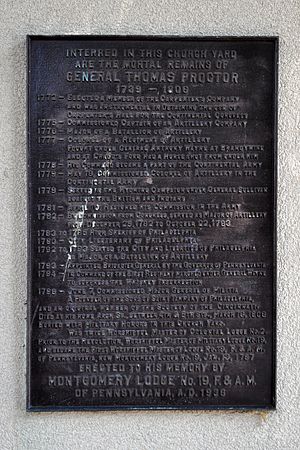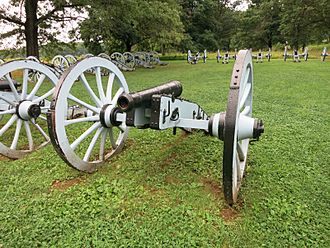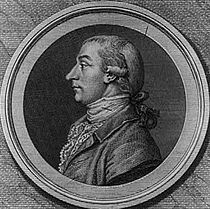Thomas Proctor (general) facts for kids
Quick facts for kids
Thomas Proctor
|
|
|---|---|
| Born | 1739 County Longford, Ireland |
| Died | 16 March 1806 Philadelphia, Pennsylvania |
| Allegiance | |
| Service/ |
|
| Years of service | 1775–1781 |
| Rank | Major General (Militia) |
| Commands held | 4th Continental Artillery Regiment |
| Battles/wars | |
| Spouse(s) |
|
| Children | 3 |
| Other work |
|
Thomas Proctor (1739 – 1806) was an important military leader during the American Revolutionary War. He was born in County Longford, Ireland. Later, he moved to America and became a carpenter in Philadelphia, Pennsylvania.
In 1775, he became an artillery captain and started a special artillery company for Pennsylvania. His company grew, and he was promoted to major. He led his soldiers, who used cannons, in battles like Princeton in 1777. He later became a colonel and helped create a larger artillery regiment.
Proctor's regiment officially joined the Continental Army in 1777. He fought bravely in major battles such as Brandywine and Germantown. He also took part in the Sullivan Expedition against the Iroquois Nation. His regiment was later called the 4th Continental Artillery Regiment. He left the army in 1781 after some disagreements.
After the war, Proctor served as a sheriff in Philadelphia. He also went on a peace mission to Native American tribes. He became a brigadier general and then a major general in the militia. He helped stop the Whiskey Rebellion. Thomas Proctor passed away in Philadelphia in 1806.
Contents
Early Life and Family
Thomas Proctor was born in County Longford, Ireland, in 1739. His parents were Francis and Betsey Proctor. His family first moved to Nova Scotia and then to the American colonies. In the 1750s, he learned the trade of a carpenter.
In 1766, he married Mary Fox in Philadelphia. They had four children: Anna, Jacob, Mary, and Thomas. Thomas Proctor joined the Carpenter's Guild in Philadelphia, Pennsylvania in 1772. He remained a member of this guild for the rest of his life.
Serving in the American Revolution
Starting an Artillery Company (1775–1777)
When the American Revolution began, Pennsylvania decided to create an artillery company. On October 27, 1775, Thomas Proctor asked to be its captain, and his request was quickly approved. His company was kept near Philadelphia to protect Fort Island.
At first, Proctor's company had only 25 soldiers. But by May 1776, it grew to 100 men. These soldiers were skilled in using cannons. Some of them even served on a ship called the USS Hornet during a fight with a British ship.
Because of their good performance, Pennsylvania added a second artillery company. This created the Pennsylvania State Artillery Battalion. Proctor was promoted to major and worked hard to recruit more soldiers. In September, his battalion joined George Washington's main army.
Fighting with Washington's Army
In December 1776, Proctor's artillery company joined Washington's army. They had two brass 6-pounder cannons. They fought in the Battle of Trenton on December 26, 1776. Their cannons helped stop the enemy.
The next day, January 2, 1777, Proctor's gunners fought in the Battle of the Assunpink Creek. They had six cannons supporting American troops. The American artillery commander, Henry Knox, said he had many guns in this battle.
On January 3, Proctor led his artillery soldiers at the Battle of Princeton. After the battle, they captured a British cannon. Proctor was put in temporary command of all the army's artillery.
Becoming a Continental Colonel
In February 1777, Proctor's battalion became the Pennsylvania State Artillery Regiment. It was ordered to recruit eight companies. Proctor was promoted to colonel and took command of this new regiment.
In June 1777, Proctor's regiment officially joined the Continental Army. Washington ordered them to join his main army. They moved to Chester, Pennsylvania, to prepare for battle.
Key Battles of 1777
During the Battle of Brandywine on September 11, 1777, Proctor's artillery defended a position called Chadds Ford. They had four cannons, including French-made ones. They fought a long artillery duel with the British. Proctor's guns caused many casualties before the British finally captured their position.
At the Battle of Germantown on October 4, 1777, American troops faced British soldiers hiding in the Benjamin Chew House. Proctor's artillery, with four cannons, fired at the house. They tried to break through its thick stone walls. Despite their efforts, the house was too strong for their light cannons.
Later Years of the War (1778–1781)
In February 1778, Washington noted that Proctor's Regiment had lost many soldiers. They were at Valley Forge during the harsh winter.
At the Battle of Monmouth on June 28, 1778, Proctor led 12 cannons. These guns were placed on a ridge and fired at the British. They had a two-hour artillery fight. When more American cannons attacked from the side, the British had to retreat.
Proctor's Regiment officially became part of the Continental Army in September 1778. Before this, it was a state unit. Proctor often had disagreements with Pennsylvania leaders about supplies. In May 1779, Congress finally made Proctor a colonel in the Continental Army.
Proctor also joined the Sullivan Expedition in 1779. This expedition was against the Iroquois Nation. Proctor's cannons helped surprise the Iroquois in the Battle of Newtown. The expedition destroyed Iroquois towns and crops.
In 1780, Proctor was at the Battle of Bull's Ferry. His cannons helped in a cattle raid. However, they could not capture a strong blockhouse. Proctor resigned from the army in April 1781 due to disagreements. Washington wrote a letter praising Proctor's service and experience.
After the War
After the war, Thomas Proctor became the sheriff of Philadelphia County from 1783 to 1785. His first wife, Mary, passed away in 1789.
In 1791, Henry Knox, who was then the Secretary of War, sent Proctor on a peace mission. Proctor traveled to meet the Wabash and Miami tribes near Lake Erie. He spent two months among the Native Americans.
Proctor continued his military service in the militia. He became a major of artillery in 1792 and a brigadier general in 1793. In 1794, he led a group of 1,849 men to help put down the Whiskey Rebellion. This was a protest by farmers against a tax on whiskey.
In 1796, Proctor married Sarah Ann Hussey. They had one child, Mary. He was promoted to major general of militia in 1796. Thomas Proctor died in Philadelphia on March 16, 1806. He was buried at Saint Paul's Episcopal Church. He was also a Freemason and a founding member of the Society of the Cincinnati.






